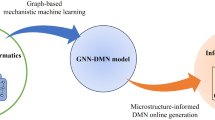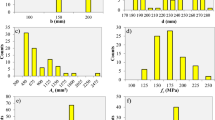Abstract
On the microscale, most composite materials are composed of heterogeneous materials comprising two or more different phases, such as matrices and inclusions. In addition, composite materials may exhibit high variability, depending on the material and amount of material used. Hence, the effect of microstructure on the macroscopic structural analysis of composite materials must be considered. Computational homogenization can be used to describe an effective constitutive model for heterogeneous composites at the microscopic level. However, a significant computational cost may be incurred owing to the iterative procedure when considering the inelastic behavior of composite materials. Hence, an efficient data-driven model reduction technique, i.e., a deep-learned surrogate model, is proposed. The key idea of the proposed framework is twofold: (1) Data-driven unsupervised model reduction for efficiently managing high-dimensional data from the microstructure and for extracting those features, and (2) the construction of parameterized constitutive models with inelastic behavior by connecting macro- and microscopic levels. Each aspect leverages a variational autoencoder and a gated recurrent unit, which are state-of-the-art components for deep learning. To demonstrate the efficiency and accuracy of the proposed model, the proposed model is applied to a two-dimensional microstructure problem involving inelastic behavior. Consequently, it is discovered that the present surrogate model can provide improved computational efficiency and accuracy within a prescribed parametric space.
















Similar content being viewed by others

References
Feyel F (1999) Multiscale FE2 elastoviscoplastic analysis of composite structures. Comput Mater Sci 16(1):344–354. https://doi.org/10.1016/S0927-0256(99)00077-4
Feyel F, Chaboche J-L (2000) FE2 multiscale approach for modelling the elastoviscoplastic behaviour of long fibre SiC/Ti composite materials. Comput Methods Appl Mech Eng 183(3):309–330. https://doi.org/10.1016/S0045-7825(99)00224-8
Terada K, Kikuchi N (2001) A class of general algorithms for multi-scale analyses of heterogeneous media. Comput Methods Appl Mech Eng 190(40):5427–5464. https://doi.org/10.1016/S0045-7825(01)00179-7
Kouznetsova V, Brekelmans WAM, Baaijens FPT (2001) An approach to micro-macro modeling of heterogeneous materials. Comput Mech 27(1):37–48. https://doi.org/10.1007/s004660000212
Geers MGD, Kouznetsova VG, Brekelmans WAM (2010) Multi-scale computational homogenization: trends and challenges. J Comput Appl Math 234(7):2175–2182. https://doi.org/10.1016/j.cam.2009.08.077
Qiao K, Xu X (2022) Parallel multiscale numerical framework of the non-linear failure analysis for three-dimension composite structures. Int J Aeronaut Space Scie 23(1):77–91. https://doi.org/10.1007/s42405-021-00430-7
Matouš K, Geers MGD, Kouznetsova VG, Gillman A (2017) A review of predictive nonlinear theories for multiscale modeling of heterogeneous materials. J Comput Phys 330:192–220. https://doi.org/10.1016/j.jcp.2016.10.070
Yvonnet J, He Q-C (2007) The reduced model multiscale method (R3M) for the non-linear homogenization of hyperelastic media at finite strains. J Comput Phys 223(1):341–368
Hernández JA, Oliver J, Huespe AE, Caicedo MA, Cante JC (2014) High-performance model reduction techniques in computational multiscale homogenization. Comput Methods Appl Mech Eng 276:149–189. https://doi.org/10.1016/j.cma.2014.03.011
Soldner D, Brands B, Zabihyan R, Steinmann P, Mergheim J (2017) A numerical study of different projection-based model reduction techniques applied to computational homogenisation. Comput Mech 60(4):613–625. https://doi.org/10.1007/s00466-017-1428-x
van Tuijl RA, Remmers JJC, Geers MGD (2020) Multi-dimensional wavelet reduction for the homogenisation of microstructures. Comput Methods Appl Mech Eng 359:112652. https://doi.org/10.1016/j.cma.2019.112652
Roussette S, Michel JC, Suquet P (2009) Nonuniform transformation field analysis of elastic-viscoplastic composites. Compos Sci Technol 69(1):22–27. https://doi.org/10.1016/j.compscitech.2007.10.032
Liu Z, Bessa MA, Liu WK (2016) Self-consistent clustering analysis: an efficient multi-scale scheme for inelastic heterogeneous materials. Comput Methods Appl Mech Eng 306:319–341. https://doi.org/10.1016/j.cma.2016.04.004
Ferreira BP, Andrade Pires FM, Bessa MA (2022) Adaptivity for clustering-based reduced-order modeling of localized history-dependent phenomena. Comput Methods Appl Mech Eng 393:114726. https://doi.org/10.1016/j.cma.2022.114726
Benaimeche MA, Yvonnet J, Bary B, He Q-C (2022) A K-means clustering machine learning-based multiscale method for anelastic heterogeneous structures with internal variables. Int J Numer Methods Eng 123(9):2012–2041. https://doi.org/10.1002/nme.6925
Lu X, Giovanis DG, Yvonnet J, Papadopoulos V, Detrez F, Bai J (2019) A data-driven computational homogenization method based on neural networks for the nonlinear anisotropic electrical response of graphene/polymer nanocomposites. Comput Mech 64(2):307–321. https://doi.org/10.1007/s00466-018-1643-0
Le BA, Yvonnet J, He Q-C (2015) Computational homogenization of nonlinear elastic materials using neural networks. Int J Numer Methods Eng 104(12):1061–1084. https://doi.org/10.1002/nme.4953
Minh Nguyen-Thanh V, Trong Khiem Nguyen L, Rabczuk T, Zhuang X (2020) A surrogate model for computational homogenization of elastostatics at finite strain using high-dimensional model representation-based neural network. Int J Numer Methods Eng 121:4811–4842. https://doi.org/10.1002/nme.6493
Bessa MA, Bostanabad R, Liu Z, Hu A, Apley DW, Brinson C, Chen W, Liu WK (2017) A framework for data-driven analysis of materials under uncertainty: countering the curse of dimensionality. Comput Methods Appl Mech Eng 320:633–667. https://doi.org/10.1016/j.cma.2017.03.037
Liu Z, Wu CT (2019) Exploring the 3D architectures of deep material network in data-driven multiscale mechanics. J Mech Phys Solids 127:20–46. https://doi.org/10.1016/j.jmps.2019.03.004
Lu X, Yvonnet J, Papadopoulos L, Kalogeris I, Papadopoulos V (2021) A stochastic FE2 data-driven method for nonlinear multiscale modeling. Materials. https://doi.org/10.3390/ma14112875
Vlassis NN, Ma R, Sun W (2020) Geometric deep learning for computational mechanics part I: anisotropic hyperelasticity. Comput Methods Appl Mech Eng 371:113299. https://doi.org/10.1016/j.cma.2020.113299
Yang Z, Yu C-H, Guo K, Buehler MJ (2021) End-to-end deep learning method to predict complete strain and stress tensors for complex hierarchical composite microstructures. J Mec Phys Solids 154:104506. https://doi.org/10.1016/j.jmps.2021.104506
Yang C, Kim Y, Ryu S, Gu GX (2020) Prediction of composite microstructure stress-strain curves using convolutional neural networks. Mater Design 189:108509. https://doi.org/10.1016/j.matdes.2020.108509
Logarzo HJ, Capuano G, Rimoli JJ (2021) Smart constitutive laws: inelastic homogenization through machine learning. Comput Methods Appl Mech Eng 373:113482. https://doi.org/10.1016/j.cma.2020.113482
Wang K, Sun W (2018) A multiscale multi-permeability poroplasticity model linked by recursive homogenizations and deep learning. Comput Methods Appl Mech Eng 334:337–380. https://doi.org/10.1016/j.cma.2018.01.036
Frankel AL, Jones RE, Alleman C, Templeton JA (2019) Predicting the mechanical response of oligocrystals with deep learning. Comput Mater Sci 169:109099. https://doi.org/10.1016/j.commatsci.2019.109099
Hochreiter S, Schmidhuber J (1997) Long short-term memory. Neural Comput 9(8):1735–1780
Cho K, van Merrienboer B, Gülçehre Ç, Bougares F, Schwenk H, Bengio Y (2014 ) Learning phrase representations using RNN encoder-decoder for statistical translation. CoRR, Vol. abs/1406.107
Chung J, Gülçehre Ç, Cho K, Bengio Y (2014) Empirical evaluation of gated recurrent neural networks on sequence. CoRR, Vol. abs/1412.3555
Chen Q, Jia R, Pang S (2021) Deep long short-term memory neural network for accelerated elastoplastic analysis of heterogeneous materials: an integrated data-driven surrogate approach. Compos Struct 264:113688. https://doi.org/10.1016/j.compstruct.2021.113688
Wu L, Nguyen VD, Kilingar NG, Noels L (2020) A recurrent neural network-accelerated multi-scale model for elasto-plastic heterogeneous materials subjected to random cyclic and non-proportional loading paths. Comput Methods Appl Mech Eng 369:113234. https://doi.org/10.1016/j.cma.2020.113234
Zhang R, Chen Z, Chen S, Zheng J, Büyüköztürk O, Sun H (2019) Deep long short-term memory networks for nonlinear structural seismic response prediction. Comput Struct 220:55–68. https://doi.org/10.1016/j.compstruc.2019.05.006
Ghavamian F, Simone A (2019) Accelerating multiscale finite element simulations of history-dependent materials using a recurrent neural network. Comput Methods Appl Mech Eng 357:112594. https://doi.org/10.1016/j.cma.2019.112594
Kingma DP, Welling M (2013) Auto-encoding variational bayes. arXiv preprint arXiv:1312.6114
Chen CN (1992) An acceleration method in elasto-plastic finite element computation. Comput Struct 44(1–2):125–132
Abbo AJ (1997) Finite element algorithms for elastoplasticity and consolidation. University of Newcastle Callaghan, Newcastle
Nayak GC, Zienkiewicz OC (1972) Elasto-plastic stress analysis. A generalization for various contitutive relations including strain softening. Int J Numer Methods Eng 5(1):113–135. https://doi.org/10.1002/nme.1620050111
de Souza Neto EA, Peric D, Owen DRJ (2011) Computational methods for plasticity: theory and applications. John Wiley & Sons, Hoboken
Defining plasticity in abaqus.
Kingma DP, Ba J. Adam: a method for stochastic optimization. arXiv:1412.6980. https://doi.org/10.48550/arXiv.1412.6980
Clevert D-A, Unterthiner T, Hochreiter S. Fast and accurate deep network learning by exponential linear units (ELUs). arXiv:1511.07289. https://doi.org/10.48550/arXiv.1511.07289
Shin H, Choi J, Cho M (2019) An efficient multiscale homogenization modeling approach to describe hyperelastic behavior of polymer nanocomposites. Compos Sci Technol 175:128–134. https://doi.org/10.1016/j.compscitech.2019.03.015
Mooney M (1940) A theory of large elastic deformation. J Appl Phys 11(9):582–592. https://doi.org/10.1063/1.1712836
Rivlin RS, Rideal EK (1949) Large elastic deformations of isotropic materials VI. Further results in the theory of torsion, shear and flexure. Philos Transact R Soc Lond 242(845):173–195. https://doi.org/10.1098/rsta.1949.0009
Bergström J (2015) 5 Elasticity/hyperelasticity. In: Bergström J (ed) Mechanics of solid polymers. William Andrew Publishing, Norwich, pp 209–307
Acknowledgements
This study was supported by a research grant from the Korea Electric Power Corporation for a basic research and development project initiated in 2021 (R21XO01-6) and by the National Research Foundation of Korea (NRF) grant funded by the Korean government (MSIT) (No. 2020R1C1C1006006).
Author information
Authors and Affiliations
Corresponding author
Ethics declarations
Conflict of interest
The authors declare that they have no conflict of interest.
Additional information
Publisher's Note
Springer Nature remains neutral with regard to jurisdictional claims in published maps and institutional affiliations.
Appendices
Appendix 1
A. Network Training History: Two-Dimensional Microstructure Under Uniaxial Tension
The network hyperparameters of the VAE and GRU were manually adjusted to train each network. First, VAEs, which extract features of stress fields for each component \(({\sigma }_{11}\), \({\sigma }_{22}\), \({\sigma }_{12}\)) and phase (matrix, fiber), were trained by a learning rate of \(1\times {10}^{-5}\) and a batch size of 256. Also, epoch, known as an iteration of the training network, was set to be 10,000 and 20,000 when training the matrix region and the fiber region, respectively. Then, GRUs, which connect the macro strain and stress field of each component, were trained by a learning rate of \(1\times {10}^{-4}\), batch size of 1024, and epoch of 5000. Convergence histories in the training and validation of different components and material phases are shown in Figs.
17,
18 and
19. The loss per epoch was evaluated by the Eq. 13, and MSE described in Sect. 3 for VAE and GRU, respectively.
It is noted that the training histories undergoes stable decaying and convergence with respect to the training progresses. As a result, each network provided benign training characteristics without overfitting. It can be seen by the value of R2 as a network training evaluation in Sect. 5.1.1 as well.
B. Network Training History: Two-Dimensional Microstructure with Interphase Zone Under Uniaxial Tension
The hyperparameters related to the network training of VAE and GRU are manually tuned, as summarized in Table 4. The training histories for each network (trained by applying the corresponding hyperparameters as summarized in Table 4) are shown in Figs.
20,
21,
22 and
23. Likewise, in the previous example, entire networks were trained well with stable convergence characteristics.
Rights and permissions
Springer Nature or its licensor (e.g. a society or other partner) holds exclusive rights to this article under a publishing agreement with the author(s) or other rightsholder(s); author self-archiving of the accepted manuscript version of this article is solely governed by the terms of such publishing agreement and applicable law.
About this article
Cite this article
Kim, H., Jeong, I., Cho, H. et al. Surrogate Model Based on Data-Driven Model Reduction for Inelastic Behavior of Composite Microstructure. Int. J. Aeronaut. Space Sci. 24, 732–752 (2023). https://doi.org/10.1007/s42405-022-00547-3
Received:
Revised:
Accepted:
Published:
Issue Date:
DOI: https://doi.org/10.1007/s42405-022-00547-3










